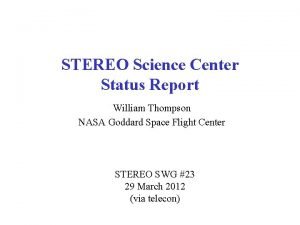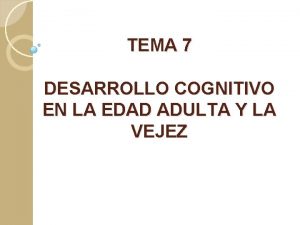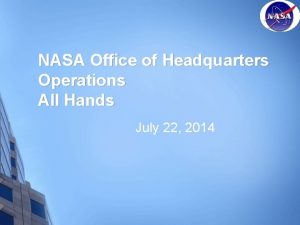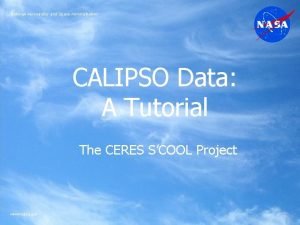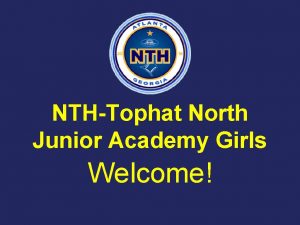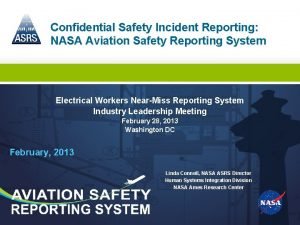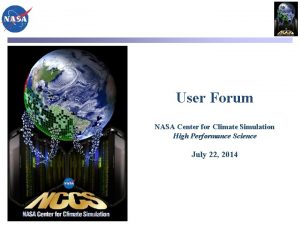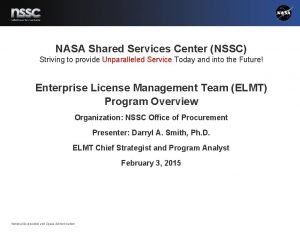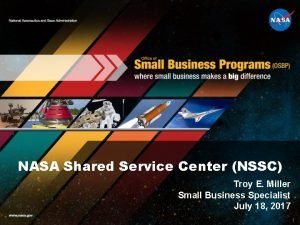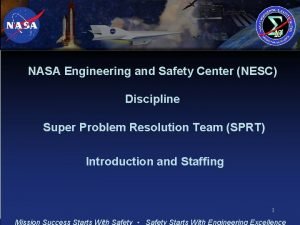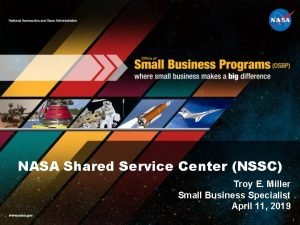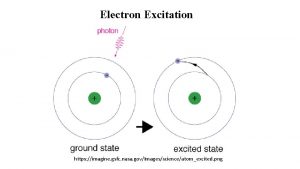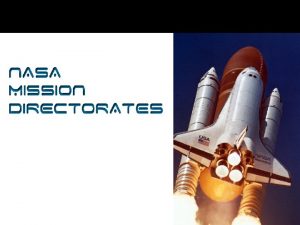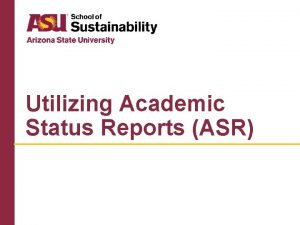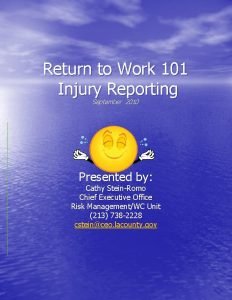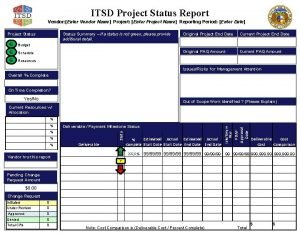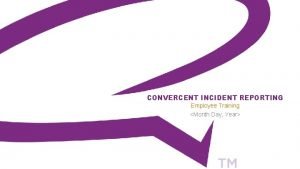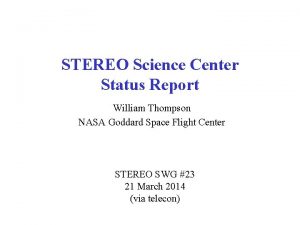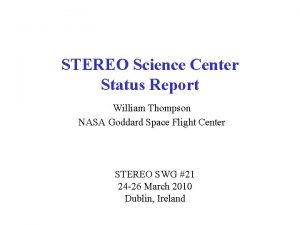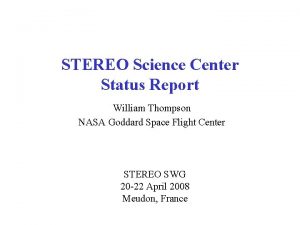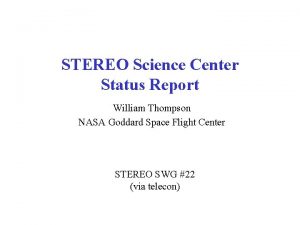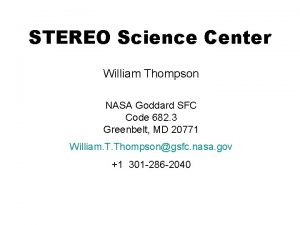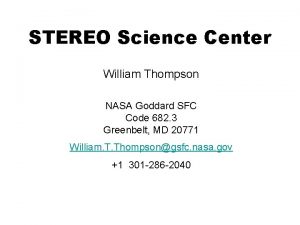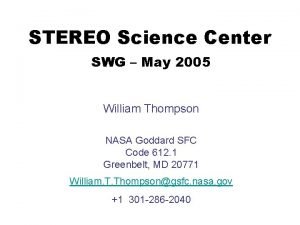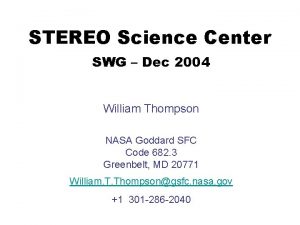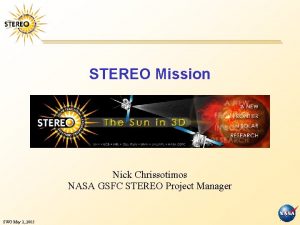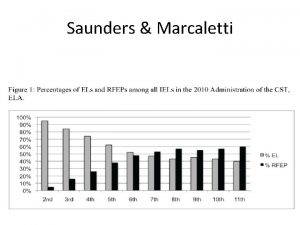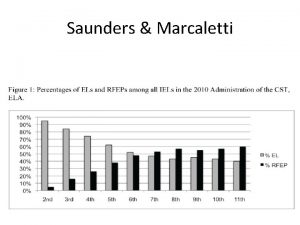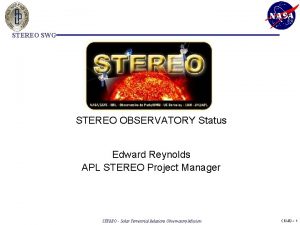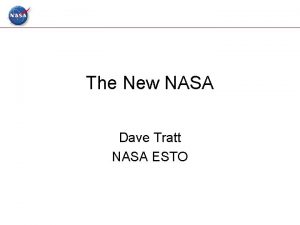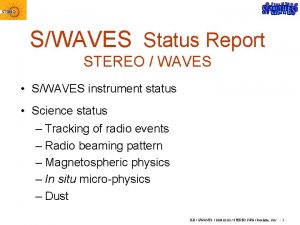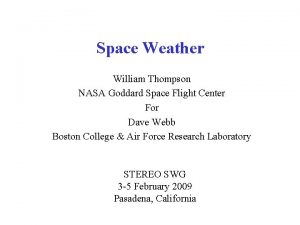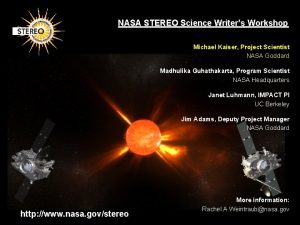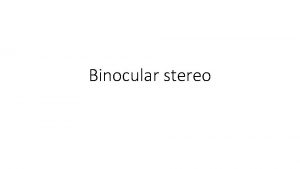STEREO Science Center Status Report William Thompson NASA






















- Slides: 22

STEREO Science Center Status Report William Thompson NASA Goddard Space Flight Center STEREO SWG 3 -5 February 2009 Pasadena, California

Recent Science Events • Whole Heliospheric Interval – March 20 – April 16 – Multi-mission campaign to observe the Sun and heliosphere over a complete solar rotation • SUMER observing period, June 20 -30 • Total Solar Eclipse, August 1 – Passed through arctic, Russia, China • MESSENGER fly-by of Mercury, Oct 6

Upcoming Science Opportunities • 2009 – DAWN fly-by of Mars, Feb 17, 2009 – Herschel sounding rocket launch, ICAL 14 • February/March – SUMER campaign, April 15 -29 – SUMI sounding rocket launch, April 16 – Sunrise 5 -day balloon flight, June 1 – July 10 – Total solar eclipse, July 22, China – Messenger fly-by of Mercury, September 29 • Behind in quadrature with Mercury – STEREO-Behind at L 5, September-November • Interest as test for possible future SWx mission • Ahead at L 4 about the same time – SUMER campaign, Nov 1 – Dec 15

DAWN fly-by of Mars 17 February 2009 Messenger fly-by of Mercury 29 September 2009

Proposed HI L 4/L 5 Campaign • Expect dust enhancements (which could be spread quite widely) and even some rocky objects. • Monthly rolls of the spacecraft by 180 degrees - from NOW - to allow HI to view the L 4/L 5 regions as we approach. Six hours once a month, taking 'synoptic' image sequences, i. e. no modification to cadences, exposures. . . • Periods of 180 rolls (quarter of a day each) to monitor dust impacts as we pass through the 'cloud' - to be done during October and November. Frequency TBD. • Synoptic operations for the rest of the passage utilizing current imaging schemes to extract any dust or rocky object imaging.

Much Farther Ahead • 2010 – Total solar eclipse, July 11, South Pacific • 2011 – Messenger Mercury orbital insertion, March 18 – DAWN arrives at Vesta, August • 2012 – DAWN leaves Vesta, May • 2014 – MAVEN arrives at Mars, September • 2015 – DAWN arrives at Ceres – STEREO goes behind Sun (3°) • Ahead, Feb 17–Aug 2 • Behind, Jan 10–Apr 12, Jul 23–Nov 10

Data Availability • Following plots show data archived within SSC for various data levels. • Instrument resource pages now available for all instruments. – Alex Young has put together alternative pages for IMPACT, PLASTIC, and SECCHI, based on the SOHO model. • Data available through Virtual Solar Observatory, but customized interface is still not available – Much data available through individual instrument data pages • Currently, there is a problem retrieving SECCHI data from NRL site – IDL routine SECCHI_VSO_INGEST will retrieve data

Level 1 software not yet delivered, but ASCII files available

Provided as software Combined with WIND/WAVES In beta-test ASCII files available for LET, HET, MAG

Provided as software

Instrument Data Pages • Split off list of instrument data pages as a separate page • Lists all data pages currently known • Need to know what data should be archived within SSC

Beacon Status • Receive beacon telemetry from England Japan on a regular basis. – French station in Toulouse has been down since June because of mechanical problems • No word yet on when it will be back up – Not certain about continued funding for station in England – NOAA examining link margins for extended mission • Switch from Convolutional to Turbo encoding • Possibly changing the modulation index – Some possible additional stations have come to light from article in Science@NASA and spaceweather. com. • Plan for real-time ASCII files. (Need software from IMPACT team. )

Beacon Volunteers • A story in Science@NASA mentioned that we’re looking for antennas to bring down the beacon telemetry • A number of amateur groups and companies have volunteered antennas. • Some possible stations that may come out of this effort: • • Jamesburg Moon Bounce Team, 30 meters, California AMSAT-DL, 20 meters, Germany Amateur 9 and 7 meter dishes, Germany CTO – CSS Robotics, 10 meters (? ), Michigan

Science Publication Database • The STEREO publication database is now online. • Contains published papers only. • Links to online versions of the papers from the publishers • Send new entries to C. Alex. Young @nasa. gov

Gallery • A lot of work has been done on the STEREO gallery • We encourage everybody to send us your best stuff • Should also inform us of upcoming press releases i. e. Mike, Rani

Outreach to Informal Educators • Astronomy clubs, amateur astronomy efforts (including star parties), science centers, NASA IYA student ambassadors • Over 100 boxes/packets sent out • Materials often redistributed to teachers and presenters in schools, scouts, etc.

Supported Events • Booths manned and materials distributed at Goddard at Annapolis Day, AARP Convention, ASTC Conf. , Goddard Open House, Natl. Science Teachers Association Conf. , Pa. Science Teachers Association Conf. , and NASA at the Smithsonian Air and Space Museum

Digital Presence • STEREO movies and images grab the attention of the public though NASA portal, APOD, STEREO galleries. • SOHO Pick of the Week, often featuring STEREO, goes to 200 kiosks via View. Space and 30 sites through the American Museum of Natural History's Astro. Bulletins.

Telemetry Rate Changes Date Ahead Date Behind Downlink (kbps) Pass duration (hrs) Daily volume (Gbits) Jan 2007 720 4 5 Oct 2008 Sep 2008 480 5 5 May 2009 June 2009 360 6 5 Aug 2009 Sep 2009 240 7 4 May 2010 Dec 2009 160 8 2. 7 Apr 2011 Nov 2010 120 8 2. 1 Sep 2011 96 8 1. 7 Aug 2012 30 10 0. 6

Extended Mission Strategy • Space weather beacon telemetry will be unaffected. – SECCHI SWx telemetry will not be stored on the SSR. • Spacecraft housekeeping rates will drop proportionally to the overall rate. • Instruments will only put housekeeping data in the realtime stream, with science data written to the SSR. – SECCHI already does this. The SECCHI housekeeping rate will drop from the current 3. 6 kbps to 2. 2 kbps. This will drop again to 1. 2 kbps when the overall rate drops to 96 kbps. – Optional realtime modes for special instrument operations • All instruments, including the in situ instruments, will lower their science rates.


SECCHI Operations Changes • Currently, the SSR write pointers aren’t moved until the end of the pass. – With the much longer pass durations, the concern is that the buffer will reach capacity before the pointers are moved. – May request that the pointers also be moved at pass midpoint. • Currently, both the synoptic (SSR 1) and special event (SSR 2) partitions are read out simultaneously. – Priority is to ensure that SSR 1 emptied every pass. – If SSR 2 is read out while still being written (i. e. no event trigger), then images are corrupted, wasting telemetry bandwidth. – Request better scheme for prioritizing SSR 1 versus SSR 2. • Different DFDs depending on NRL requests? • Read out SSR 1 first, and then SSR 2?
 Stereo science center
Stereo science center Desarrollo cognitivo en la edad adulta
Desarrollo cognitivo en la edad adulta Victor thompson nasa
Victor thompson nasa Writing a status report
Writing a status report William thompson scalp
William thompson scalp Ano ang kahulugan ng awit
Ano ang kahulugan ng awit Calipso browse images
Calipso browse images United quest park
United quest park Science is my favourite subject
Science is my favourite subject Nasa safety report
Nasa safety report Nasa center for climate simulation
Nasa center for climate simulation Nasa shared service center
Nasa shared service center Nasa shared service center
Nasa shared service center Nesc nasa
Nesc nasa Nasa shared service center
Nasa shared service center Nasa's goddard space flight center
Nasa's goddard space flight center Imagine.gsfc.nasa/gov/docs/science/know_l1/emspectrum.html
Imagine.gsfc.nasa/gov/docs/science/know_l1/emspectrum.html Nasa planetary science
Nasa planetary science Academic status report asu
Academic status report asu Work status report from doctor
Work status report from doctor Kaiser code gray
Kaiser code gray Enter vendor name
Enter vendor name Convercent/report
Convercent/report
